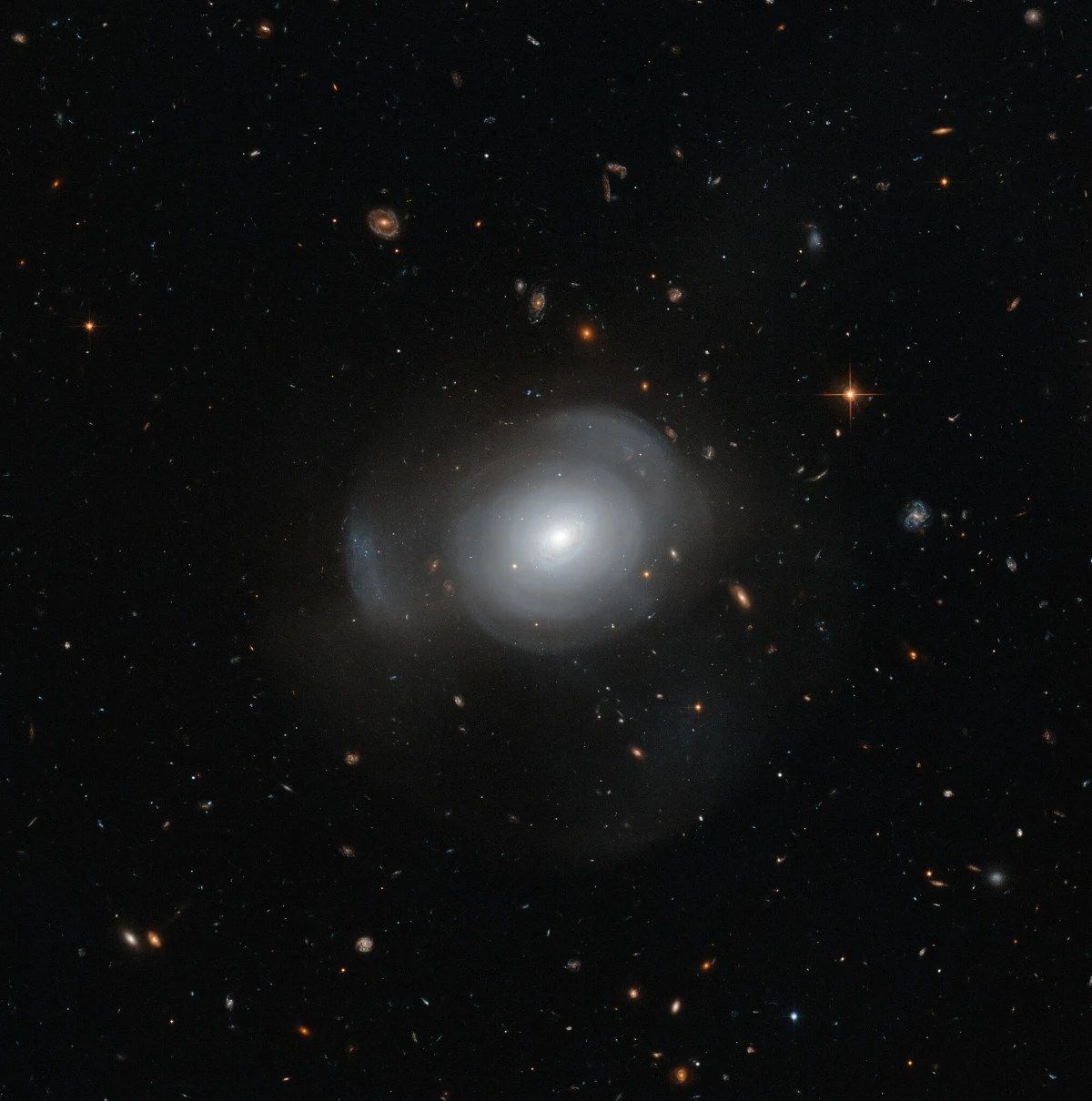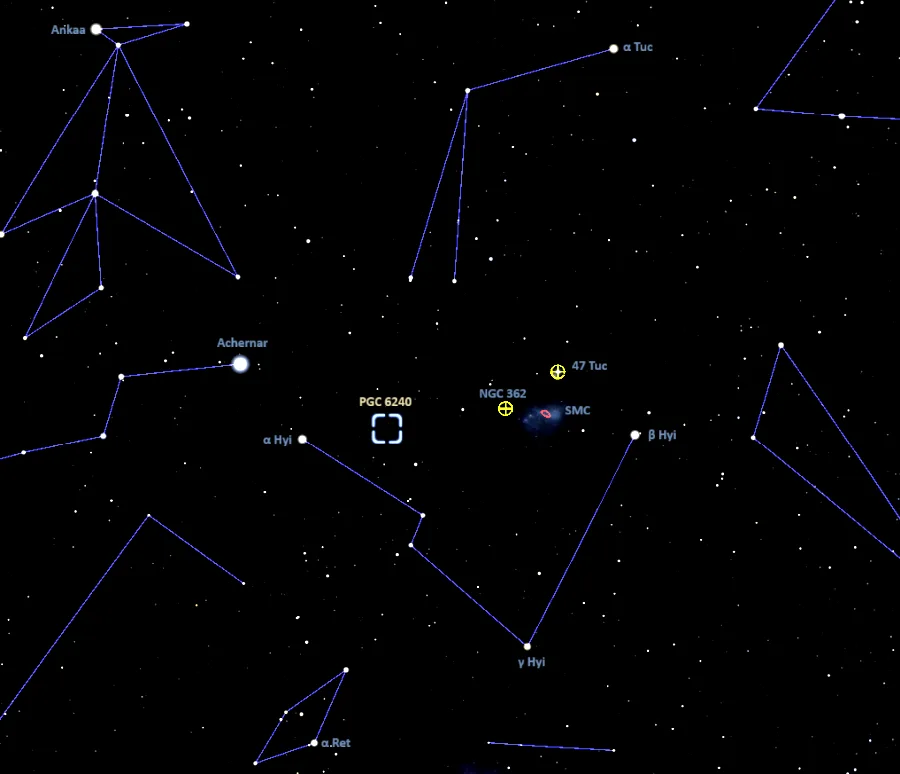The White Rose Galaxy (PGC 6240) is a large lenticular galaxy located approximately 345 light years away in the southern constellation Hydrus. The galaxy has a post-starburst spectrum and an active galactic nucleus (AGN). Combined with a fine shell-like structure, this indicates a strong burst of star formation caused by a merger in the recent past.
Some sources classify PGC 6240 as an elliptical galaxy. The galaxy has an unusually uneven structure, with several petal-like shells of stars that rotate around the bright nucleus. The smooth shells give the galaxy the appearance of a white rose in the sky.
The most likely explanation for the galaxy’s unusual appearance is that the shells formed during a merger that sent ripples through the galaxy, igniting a burst of star formation and forming the concentric shells of material around the bright core.

The beautiful, petal-like shells of galaxy PGC 6240 are captured here in intricate detail by the NASA/ESA Hubble Space Telescope, set against a sky full of distant background galaxies. The galaxy is orbited by a number of globular clusters that contain both young and old stars — thought to be a result of a galactic merger in the recent past. Image credit: ESA/Hubble & NASA (CC BY 4.0)
The shells are irregularly distributed around the main body of the galaxy. The innermost hazy shells appear closer together, while the outermost ones appear almost detached from the galaxy. The brightest shell contains the youngest star clusters in the galaxy, which indicates that both the shells and the young blue clusters formed as a result of the same galactic collision. Astronomers believe that at least one of the galaxies involved in the merger was rich in gas, which would have made two major episodes of star formation possible.
Imaging with the Advanced Camera for Surveys (ACS) aboard the Hubble Space Telescope (HST) in 2004 revealed three distinct subpopulations of globular clusters in the galaxy. A team of astronomers led by Aparna Maybhate, Space Telescope Science Institute (STScI), Baltimore, USA, detected a centrally concentrated young population with an estimated age of around 0.4 billion years, intermediate-age clusters that are around 1 billion years old, and old, metal-poor clusters similar to those seen orbiting normal galaxies. The study was published in The Astronomical Journal in November 2007.
The scientists identified a total of 217 globular cluster candidates in the galaxy. Based on galaxy merger simulations, the ages of the two younger populations of clusters – those that are 400 million years old and those with an estimated age of 1 billion years – are consistent with the typical lifetime of shell structures that form during galactic mergers.
Facts
The Simbad database lists the spiral galaxy LEDA 127487 (PGC 127487) as a sibling galaxy of LEDA 6240 (PGC 6240). The two galaxies form a physically associated pair. The fainter galaxy appears south and a little east of the White Rose Galaxy.
Two other galaxies – LEDA 6286 and LEDA 95365 – appear closer to the White Rose in the sky, but they do not appear to be gravitationally bound to it. LEDA 6286 lies a little closer to us and LEDA 95365 is a more distant background galaxy. Hubble images of LEDA 6240 reveal many other more distant galaxies in the background.
PGC 6240 hosted a supernova observed in 2014. Designated ASASSN14mw, the supernova was discovered during the All Sky Automated Sky Survey for Supernovae (ASAS-SN) with the 14-cm Cassius telescope in Cerro Tololo, Chile, in December 2014. It was classified as a Type Ia supernova, triggered by a white dwarf that accreted too much material from a binary companion.
At the time of discovery, the supernova had a visual magnitude of 16.8. It occurred around 5.2 arcseconds south and 35.9 arcseconds west from the galactic centre of PGC 6240.
The White Rose Galaxy is not to be mistaken for the Rose Galaxy (Arp 273), a pair of interacting galaxies located in the northern constellation Andromeda. The pair lies closer to us, at a distance of 300 million light-years, and has an apparent magnitude of 13.7.
Location
The White Rose Galaxy lies in the southern constellation of Hydrus (the Lesser Water Snake). It appears about a third of the way from Alpha Hydri to the Small Magellanic Cloud (SMC).
Shining at magnitude 2.90, Alpha Hydri marks the head of Hydrus and appears close to the bright Achernar (Alpha Eridani) in the sky. The Small Magellanic Cloud, a dwarf irregular galaxy in the Milky Way’s neighbourhood, has an apparent magnitude of 2.7 and is visible to the unaided eye on a clear, dark night from areas without light pollution.
The White Rose Galaxy is a very challenging target even for larger amateur telescopes because it is very faint and small. It may be spotted in large telescopes at high magnification on very dark, moonless nights.
At declination – 65° 37′, PGC 6240 is best seen from the southern hemisphere. It never rises above the horizon for observers north of the latitude 24° N.

White Rose Galaxy location, image: Stellarium
White Rose Galaxy – PGC 6240
| Constellation | Hydrus |
| Object type | Lenticular galaxy |
| Morphological type | S0d |
| Right ascension | 01h 41m 30.906s |
| Declination | −65° 36′ 56.4″ |
| Apparent magnitude | 13.5 |
| Apparent size | 0.440′ × 0.352′ |
| Distance | 345 million light-years (106 megaparsecs) |
| Redshift | 0.027792 |
| Heliocentric radial velocity | 8216 ± 15 km/s |
| Names and designations | White Rose Galaxy, LEDA 6240, PGC 6240, AM 0139-655, IRAS 01399-6552, IRAS F01400-6551, 2MASX J01413090-6536564, 6dFGS gJ014131.0-653656, APMBGC 080-064+043, Gaia DR2 4698899937873610496, Gaia DR3 4698899937873610496 |